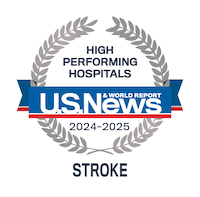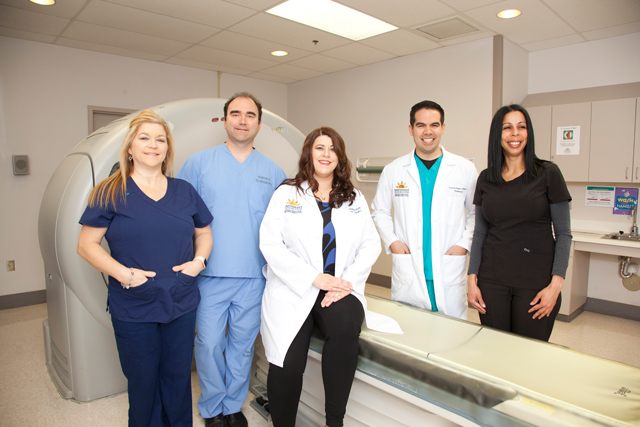Prompt, Expert Treatment for Stroke Patients
Approximately 795,000 Americans suffer a new or recurrent stroke each year, according to the Centers for Disease Control and Prevention. In fact, someone suffers a stroke every 40 seconds, making stroke a leading cause of adult disability, as well as the third-leading cause of death nationwide. According to stroke experts, a stroke should be treated with the same urgency as a heart attack. Every second is critical to patient care, survival and subsequent quality of life.
 Stroke Risk Assessment
Stroke Risk Assessment
Are you at risk for a stroke? This health assessment can help determine how likely you are to have a stroke in the future.
Advanced Primary Stroke Center
Southwest Healthcare Inland Valley Hospital has been certified by The Joint Commission as an Advanced Primary Stroke Center since 2015. This distinction recognizes centers that make exceptional efforts to foster better outcomes for stroke care.

U.S. News & World Report named Inland Valley Hospital a High Performing Hospital for Stroke for 2024-25, recognizing our commitment to a higher standard of care for stroke. Hospitals that earned a high performing rating from U.S. News & World Report were significantly better than the national average.
Performing Hospital for Stroke for 2024-25, recognizing our commitment to a higher standard of care for stroke. Hospitals that earned a high performing rating from U.S. News & World Report were significantly better than the national average.
We have also been recognized by the American Heart Association® and the American Stroke Association® for our commitment to providing appropriate treatment using evidence-based care by being awarded the Get With The Guidelines®-Stroke GOLD PLUS with Honor Roll Elite designation and the Target Stroke: Type 2 Diabetes Honor Roll Achievement Award.

Our dedicated stroke program helps foster better outcomes for stroke patients in the surrounding Wildomar area. The Advanced Primary Stroke Center offers:
- 24/7 tele-neurology services provided by vascular neurologists from UC San Diego Health
- Access to local neurological services
- Individualized care to meet stroke patient needs
- Increased awareness of stroke prevention and education throughout our community
- Rehabilitation services provided by a trained team of professionals
- A streamlined, secure and private flow of patient information
- The use of Applied Artificial Intelligence software, which helps enable quick detection and notification of suspected large vessel occlusions (LVO) in the brain
Team-based Stroke Services
A multidisciplinary medical team at Inland Valley Hospital works to evaluate and treat all stroke emergencies. To help deliver prompt, quality care, the multidisciplinary team includes:
- Emergency physicians
- Emergency nurses
- Neurologists
- Neurosurgeons
- Radiologic technologists
- Radiologists
- Laboratory technologists
Stroke patients have access to a comprehensive range of specially designed services and treatments which focus on:
- Prevention and intervention
- Education
- Active management of strokes
- Rehabilitation
Stroke Types and Symptoms
Stroke — sometimes called brain attack — occurs when there is an interruption in the flow of blood to cells in the brain. Deprived of oxygen from the blood, the cells die. A stroke occurs when either a blockage in an artery prevents blood from reaching cells in the brain or an artery ruptures inside the brain, causing bleeding.
There are two kinds of strokes:
Ischemic strokes are the most common. They occur when an artery is blocked and blood flow to the brain is stopped. Caused by build-ups of fatty deposits on the inside of an artery wall which then becomes completely clogged. Ischemic strokes account for eighty percent of all strokes suffered.
Some ischemic strokes are preceded by stroke-like symptoms called transient ischemic attacks (TIAs). These may occur months before the stroke. The loss of vision in a TIA may be described as a feeling that a shade is being pulled down over your eyes. The symptoms are usually temporary and improve within 10 to 20 minutes.
Hemorrhagic strokes occur when an artery inside the brain ruptures or when an aneurysm at the base of the brain bursts. Twenty percent of all strokes suffered are hemorrhagic strokes. Symptoms more specific to this type of stroke include headache, nausea and vomiting, neck stiffness, seizures, sudden changes in mental state and lethargy.
Hemorrhagic strokes usually occur in the daytime and during physical activity. The symptoms typically begin very suddenly and evolve over several hours.
Act F.A.S.T — Every Second Counts
Learn the many warning signs of a possible stroke. Act FAST and CALL 9-1-1 IMMEDIATELY at any sign of a stroke.
Preventing Stroke
The best way to prevent a stroke is knowing your risk factors. You can lower your risk by:
- Keeping your blood pressure controlled through lifestyle changes and/or medications
- Not smoking
- Taking steps to manage your cholesterol
- Limiting your alcohol consumption
- Exercising regularly
- Maintaining a healthy weight
- Keeping up with your regularly scheduled physician appointments
Get a physician referral
For a non-emergency referral to a physician at Inland Valley Hospital who can help assess your risk for stroke, call our free physician referral service at 1-800-879-1020.

